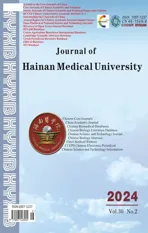Effect of different interventions on orthodontic tooth movement acceleration: A network meta-analysis
2024-04-04CHENHuiyingZHANGLiZHANLeWANNiMOLiwen
CHEN Hui-ying, ZHANG Li , ZHAN Le, WAN Ni, MO Li-wen
School of Stomatology, Hainan Medical University, Haikou 571100, China
Keywords:
ABSTRACT Objective: To explore the effectiveness of various interventions in accelerating tooth movement, a systematic review and net-work meta analysis were used to draw a conclusion.Methods: MEDLINE, EMBASE, Willey Library, EBSCO, Web of Science Databases, and Cochrane Central Register of Controlled Trials databases to identify relevant studies.ADDIS 1.16.6 and Stata 16.0 software were used for NMA.Results: Five thousand five hundred and forty-two articles were searched out.After screening by two independent investigators,forty-seven randomized controlled trials, 1 390 participants, were included in this network meta-analysis.A total of 11 interventions involving Piezocision (Piezo), Photobiomodulation therapy (PBMT), Plate- let-rich plasma(PRP), Electromagnetic field(EF), Low intensity laser therapy(LLLT), Low intensity pulsed ultrasound(LI-PUS), Low-frequency vibrations(LFV),Distraction osteogenesis(DAD), Corticotomy(Corti), Microosteoperforations (MOPS),Traditional orthodontic(OT)were identified and classified into 3 classes including surgical treatment, non-surgical treatment and traditional orthodontic treatment.According to SUCRA probability ranking of the best intervention effect, when orthodontic treatment lasted for 1 month, PBMT (90.6%), Piezo(87.4%) and MOPs(73.6%)were the top three interventions to improve the efficiency of canine tooth movement.When orthodontic treatment lasted for 2 months, Corti (75.7%), Piezo (69.6%) and LFV(58.9%)were the top three interventions for improving the mobility efficiency of canine tooth movement.When orthodontic treatment lasted for 3 months, Cort (73.3%), LLLT(68.4%)and LFV(60.8%)were the top three interventions for improving the mobility efficiency of canine tooth movement.Conclusion:PBMT and Piezo can improve the efficiency of canine tooth movement significantly after 1 month, while Corti and LFV can improve the efficiency of canine tooth movement better after 2 and 3 months.
1.Introduction
Nowadays, more and more adults are undergoing orthodontic treatment in order to improve the apperance of the lower third of face, dental aesthetics and a better masticatory ststem.In addition to the type of orthodontic appliance used in orthodontic treatment,the duration of orthodontic treatment has become the most common and important issue faced by patients and orthodontists.The average duration of treatment for fixed orthodontics is 2 years.Prolonged treatment not only increases the risk of caries,gingival inflammation,and root resorption of the outer teeth,but also increases the risk of dental caries.
Orthodontic tooth movement is achieved by remodelling of the periodontal ligament,alveolar bone and other periodontal tissues under machanical loading1.When orthodontic forces are applied to the teeth,the load is transferred from the teeth,through the periodontal ligament to the alveolar bone,causing the bone to remodel.Adjuncts utilise and amplify the patient’s normal biological response to orthodontic forces,accelerating alveolar bone reconstruction and resorption.In recent years,experts and scholars have proposed a series of including surgical methods and nonsurgical approaches to accelerate orthodontic tooth movement and shorten the process of orthodontic treatment.
A network meta-analysis is a method of comparing the effectivness of different interventions for orthodontic tooth movement by combining clinical trial data on the effectiveness of multiple treatment measures and ranking their efficacy indicators.The purpose of this network meta-analysis is to compare the treatment effects between various treatment measures,thus providing a more intuitive reference for clinician’s work.
2.Information and methodology
2.1 Literature Search Strategies
Computer searches included PubMed, Willey Library, EBSCO,Web of Science and EMBASE from the build-up to April 2023 was searche with subject terms combined with free words about the effectiveness of differet interventions on accelerated orthodontic tooth movement in English language only.The search key word were“Orthodontic Treatment”,“Periodontal accelerated orthodontic tooth movement”,“tooth movement”,“Orthodontic tooth movement”,“OTM”,“growth factors”,“electromagnetic”,“Low intensity laser therapy ”,“extracorporeal shock waves”,“Lowfrequency vibrations”,“distraction osteogenesis”,“ corticotomy”,“Piezocision”,“Micro-osteoperforations”and“surgery-first”.
2.2 Inclusion and Exclusion criteria
1.2.1 Inclusion criteria
(1)Two-and multi-group randomised controlled on accelerated orthodontic tooth movement,with no restriction on intervention or region.(2)Orthodontic patients were not restricted by age or gender.(3)/primary outcomes included cumulative tooth movement distances at 1,2 and 3 months.(4)Study type:RCTs.
1.2.2 Exclusion criteria
(1)In vitro and animal studies,non-randomised clinical trials,retrospective studies,meta-analyses,reviews,narrative articles,short newsletters,editorial letters and qualitative surveys.(2)Concurrent othognathic surgery or cleft lip or patients with cleft palate surgeries may affect the speed of tooth movement.(3)Pulp and periodontal tissue lesions’ patients.
2.3 Literature Screening and Data Extraction
Searched independently by two researchers,if the two institutes disagreed on the inclusion of literature,a third one researcher assisted in the judgement.The experimental and control groups were extracted from each of the included studies at 3 follow-up visits.Means and standard deviations of cumulative tooth movement distances during 1,2 and 3 months.Extracted articles included:first author of the published literature,year of publication of the literature,mean age of the subjects,experimental group/number of patients in the control group,orthodontic appliance system,type of malocclusion,time between extraction of first premolar and cusp retraction.
2.4 Risk of bias evaluation
Two researchers assessed the included studies on an article-by article basis according to the Cochrane Collaboration’s risk of bias tool.
2.5 Statistical processing
A reticulated Meta-analysis of various interventions was carried out using ADDIS 1.16.6 software,an analysis module that it is a multivariate Meta-analysis model based on Bayesian network model.Since this study aimed to determine the effect indicators of different interventions on the acceleration of orthodontic tooth movement in patients,which is a continuous variable,the effect size SMD was combined,and the 95% confidence interval(CI),and the joint table was plotted using Stata 16.0 software.Meanwhile,this study used the surface under the surface under the cumulative ranking(SUCRA)to rank the probability of the total effective rate of various interventions.The results of SUCRA were presented in the form of percentage,and the larger the area under the curve,and the better the therapeutic effect.Traditional Meta-analysis refer to inconsistency that occurs in reticulated Meta-analysis is also a category of heterogeneity,and the existence of heterogeneity leads to the appearance of inconsistency.Therefore,in order to ensure the reliability of the results,the direct and indirect comparisons in reticulated Meta-analysis are analysed for consistency.
3.Result
3.1 Literature search results
After computerised and manual searches,47 eligible articles were include in this research network.The detailed screening process of the literature is shown in Figure 1.
3.2 Basic information on the literature included
A total of 47 papers were included, all of which were randomised controlled trials published in English The total number of interventions was 1,390 There were 681 patients in the test group and 709 patients in the control group.The methods used to accelerate orthodontic tooth movement in the treatment group included: photobiomodulation (PBMT) platelet-rich plasma(PRB)electromagnetism(EF)low-intensity laser(LLLT)low-intensity pulsed ultrasonography (LPUS)cyclic loading vibration (LFV)periodontal distraction for osteogenesis (00) and periodontal membrane distraction/alveolar bone distraction osteogenesis (DAD)cortical osteotomy(corti) piezoelectric annuloplasty (Piezo)micro osteotomies (MOPs),and conventional treatment (OT) Details of the included literature are shown in Table l.
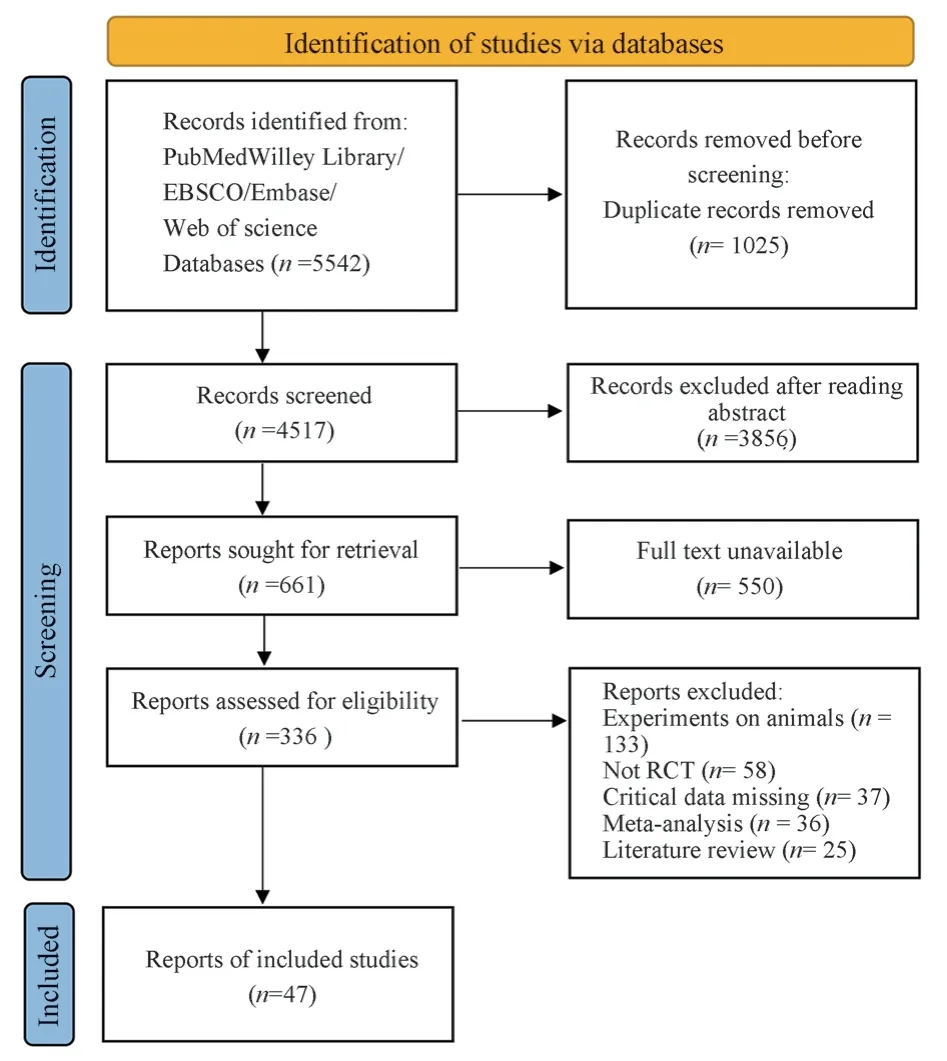
Fig 1 Flow chart of literature screening
3.3 Evaluation of the quality of the included literature
Of the 47 papers included,all stated that the randomised table of numbers method was applied to the groupings; 23 studies used a randomised table of numbers of the subjects.Subjects were blinded;22 studies had good completeness of outcome data; and overall, 34 of all studies were low risk and 13 were medium risk.The risk of bias assessment is shown in Figure 2.
3.4 Results of reticulated Meta-analysis
3.4.1 Efficiency of cusp movement daring 1 month of orthodontic treatment
The reticulation of the interventions a month of orthodontic duration is shown in Figure 3A,involving interventions.The implementation, the formation of there are 3 closed-loop, so it isnecessary to carry out congstenoy tost, By node splitting method(P >0.05) the consistency was goodand the consistency model was chosen for analysis.10 interventions were able to improve the overall clinical effectiveness of orthodontic cusp movement over 1 month compared with the OT control group,shown in table 2.PBMT was the most effective[SMD= 0.68, 95%CI(0.19, 1.2)],followed by Pieze[SMD= 0.55, 95%CI(0.35, 0.75)],and MOPS[SMD= 0.43,95%CI(0.23, 0.63)]ranked third.The top 3 SUCRA orderings were PBMT(90.6%)>Piezo(87.4%)> MOPs(73.6%), as shown in Figure 3B.
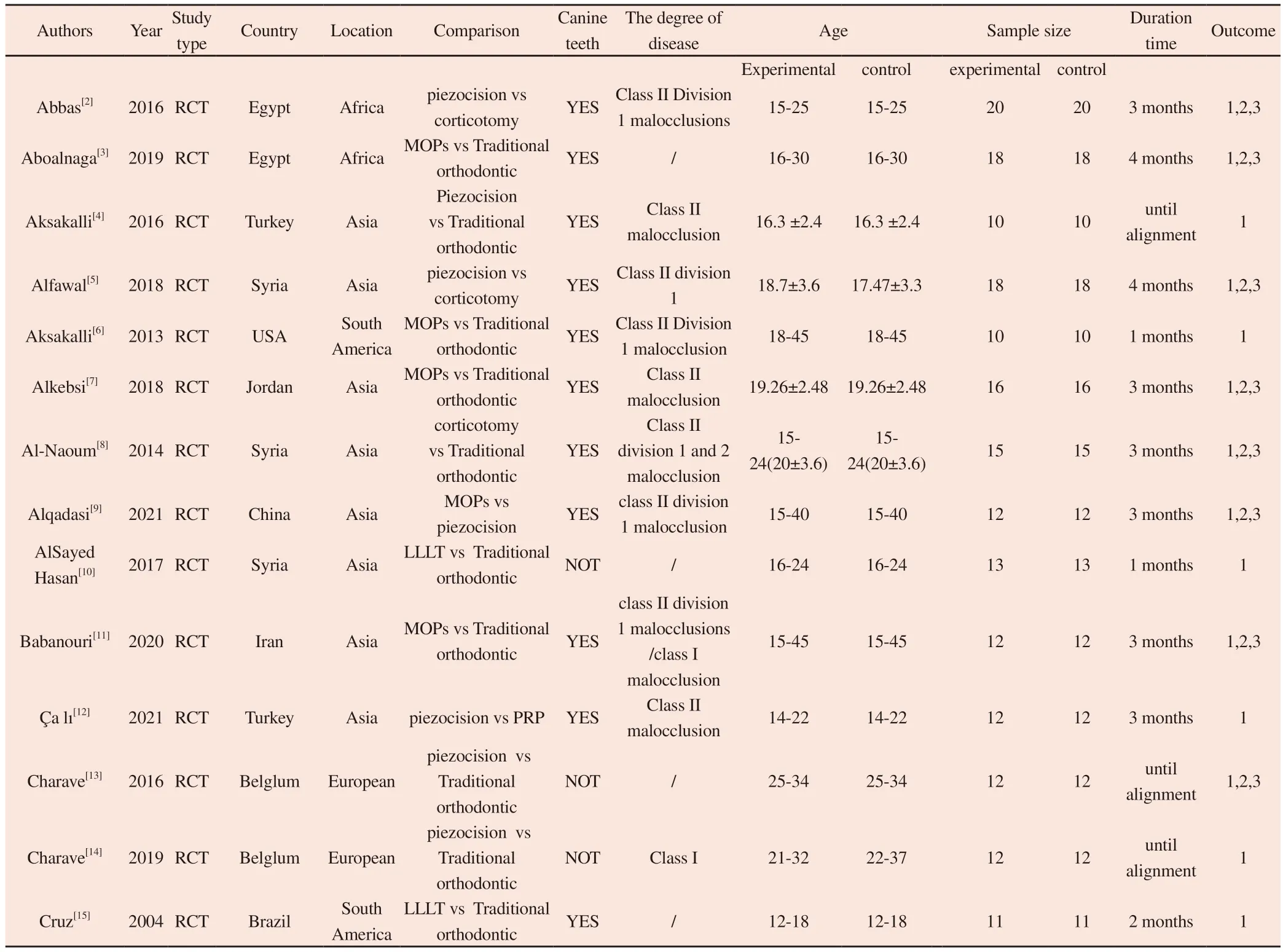
Tab 1 Basic characteristics of included studie
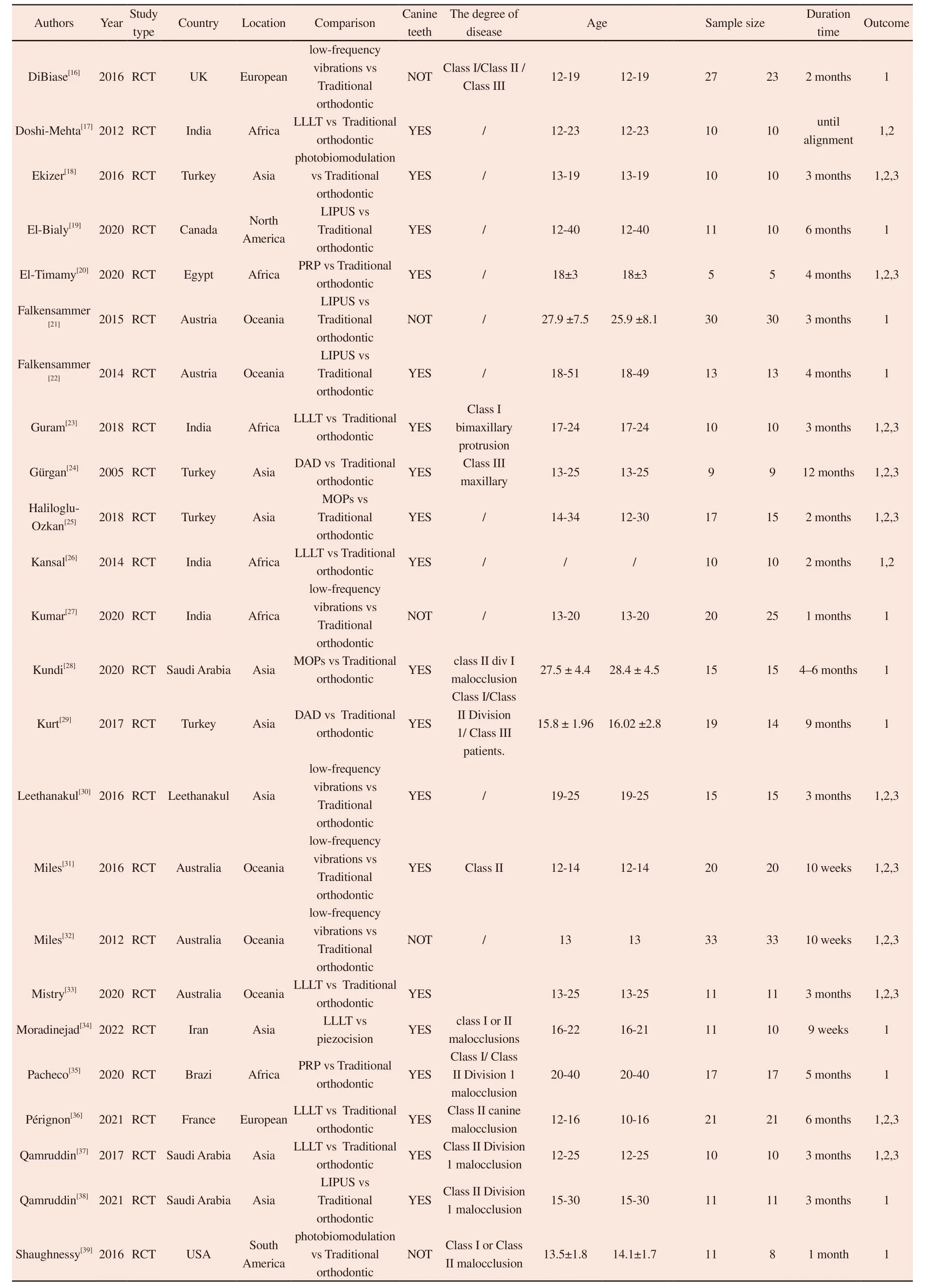
images/BZ_48_201_226_2276_3167.png

Authors Year Study type Country Location Comparison Canine teeth The degree of disease Age Sample size Duration time Outcome Showkatbakhsh[40] 2010 RCT Iran Asia electromagnetic field vs Traditional orthodontic YES Class I /Class II Division I malocclusions.23 ± 3.3 23 ± 3.3 5 5 4 months 1 Sivarajan[41] 2019 RCT Malaysia Asia MOPs vs Traditional orthodontic YES / 22 22 20 60 2 months 1 Tortamano[42] 2009 RCT Brazil.Africa LLLT vs Traditional orthodontic NOT Class III 12-18 12-18 10 10 1 week 1 Tunçer,[43] 2017 RCT USA South America piezocision vs Traditional orthodontic YES Class I /Class II malocclusion 17±3.4 17±1.4 16 15 9.3 months 1 Üretürk[44] 2017 RCT Turkey Asia LLLT vs Traditional orthodontic YES Class II division I 12-19 12-19 15 15 3 months 1 Uribe[45] 2017 RCT Saudi Arabia Asia piezocision vs Traditional orthodontic YES / 29.4 (9.3) 30 (12.5) 16 13 4 months 1 Yavuz[46] 2018 RCT Turkey Asia piezocision vs Traditional orthodontic NOT Class I malocclusions.13-18 13-18 9 12 1 months 1 Zeitounlouian[47] 2021 RCT Zeitounlouian European PRP vs Traditional orthodontic YES class II division I malocclusion 20.85± 3.85 20.85±3.85 21 21 5 months 1 Zheng[48] 2021 RCT China Asia piezocision vs Traditional orthodontic YES / 18-28 18-28 12 12 4 months 1
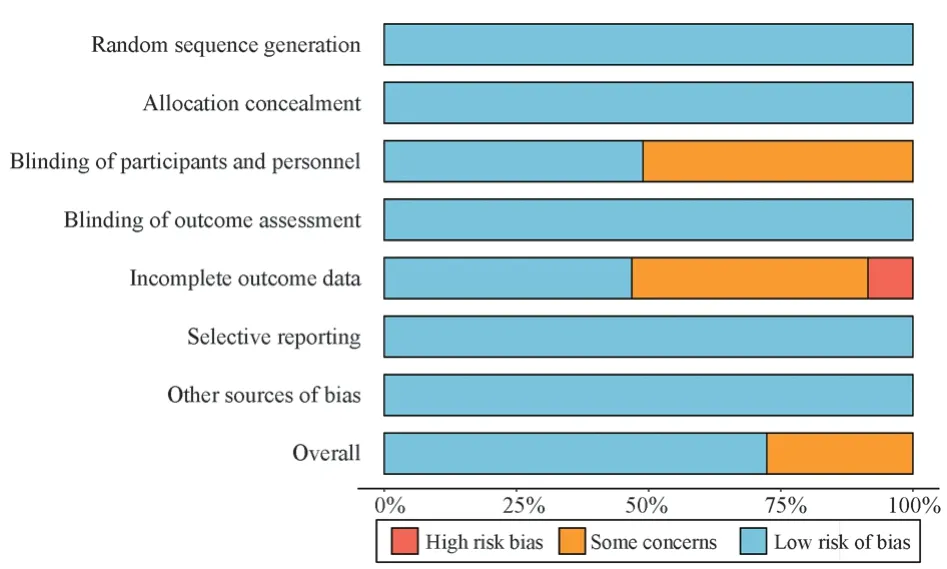
Fig 2 Risk of bias summary of literatures

Fig 3 the canine movement distance at 1 month 3a Network evidence figure; 3b Figure of SUCRA
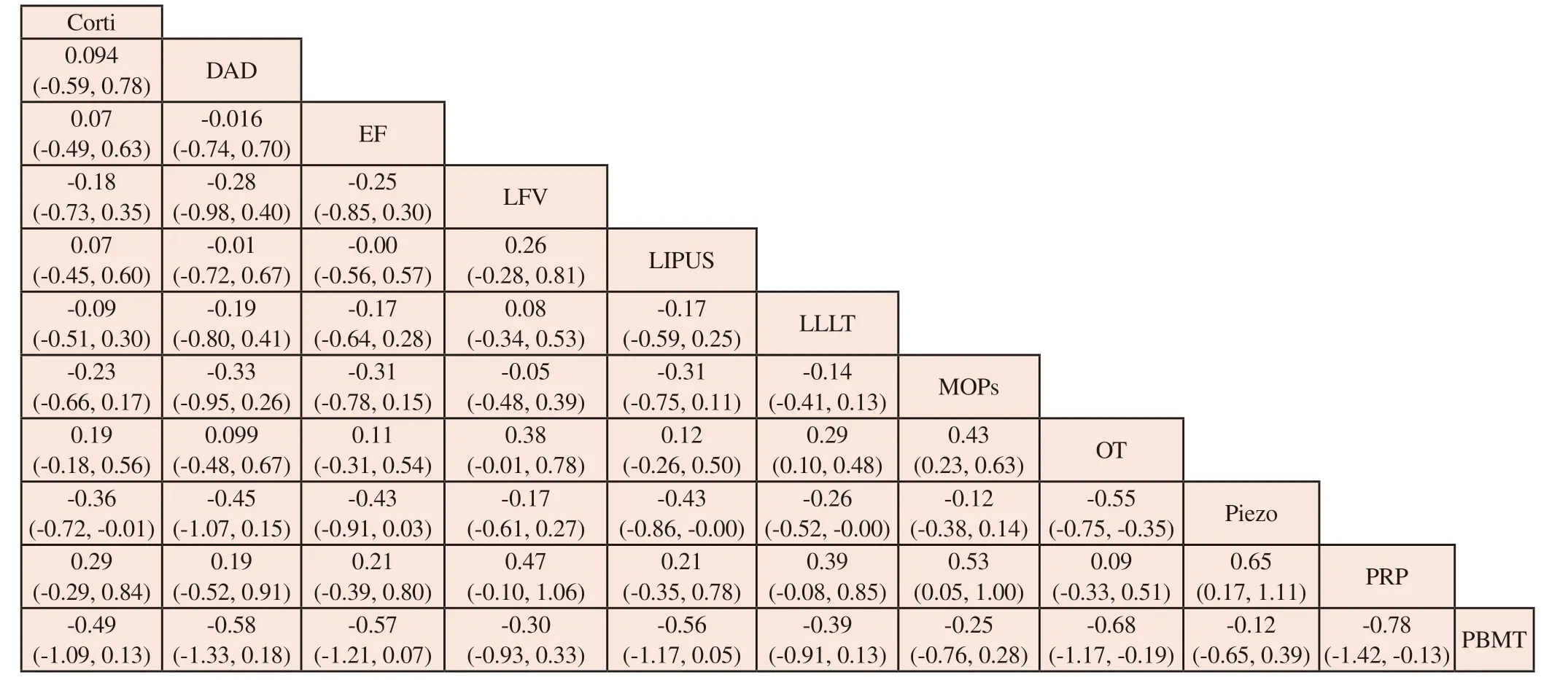
Tab 2 League table of clinical total response rate for a month of tooth movement at 1 month
3.4.2 Efficiency of cusp movement daring 2 months of orthodontic treatment
The reticulation of interventions at 2 months of orthodontic duration is shown in Figure 4A,involving 8 interventions,the there were 2 closed loops, so a consistency test was required.Nodal cleavage method showed OT vs Corti and Piezo vs Corti partial consistency tests (P<0.05) poor model consistency,and a random effects model was chosen.The remaining seven interventions improved the overall clinical effectiveness of cusp movement for orthodontic treatment lasting 2 months compared to the OT control group,and the other interventions included insufficient amounts of data,as shown in Table 3..The Corti have the best effect[SMD=0.64, 95%CI(-0.03, 1.31)], followed by Piezo [SMD=0.46, 95%CI(-0.03, 0.97)],LFV[SMD=0.40, 95%CI(-0.34,1.17)] ranked third.The top three SUCRA orders were Corti(75.7%)>Piezo(69.6%)> LFV(58.9%),as shown in Figure 4B.
3.4.3 Efficiency of cusp movement daring 3 months of orthodontic treatment
When orthodontic treatment lasted for 3 months, the mesh relationship of each intervention is shown in Figure 5A,involving 7 interventions and forming a total of 2 triangular closed loops,so a consistency test was required.From the nodal analysis,OT vs.Corti and Piezo vs.Corti local consistency test(P<0.05),the model consistency is poor, then choose to a random effects model was chosen.A total of five interventions improved the overall clinical effectiveness of cusp movement at 3 months of orthodontic treatment compared with the OT control group, with insufficient data included for the other interventions,as shown in Table 6.The best results were achieved with Cort[SMD=0.53, 95%CI(-0.18, 1.25)],followed by LLLT [SMD=0.46, 95%CI(-0.03, 0.97)], LFV[SMD=0.40,95%CI(-0.34,1.17)] ranked third.The top 3 SUCRA orders were Corti(73.3%)>LILT(68.4%) LFV(60.8%),as shown in Figure 5B.

Fig 4 The canine movement distance at 2 months 4a Network evidence figure; 4b Figure of SUCRA
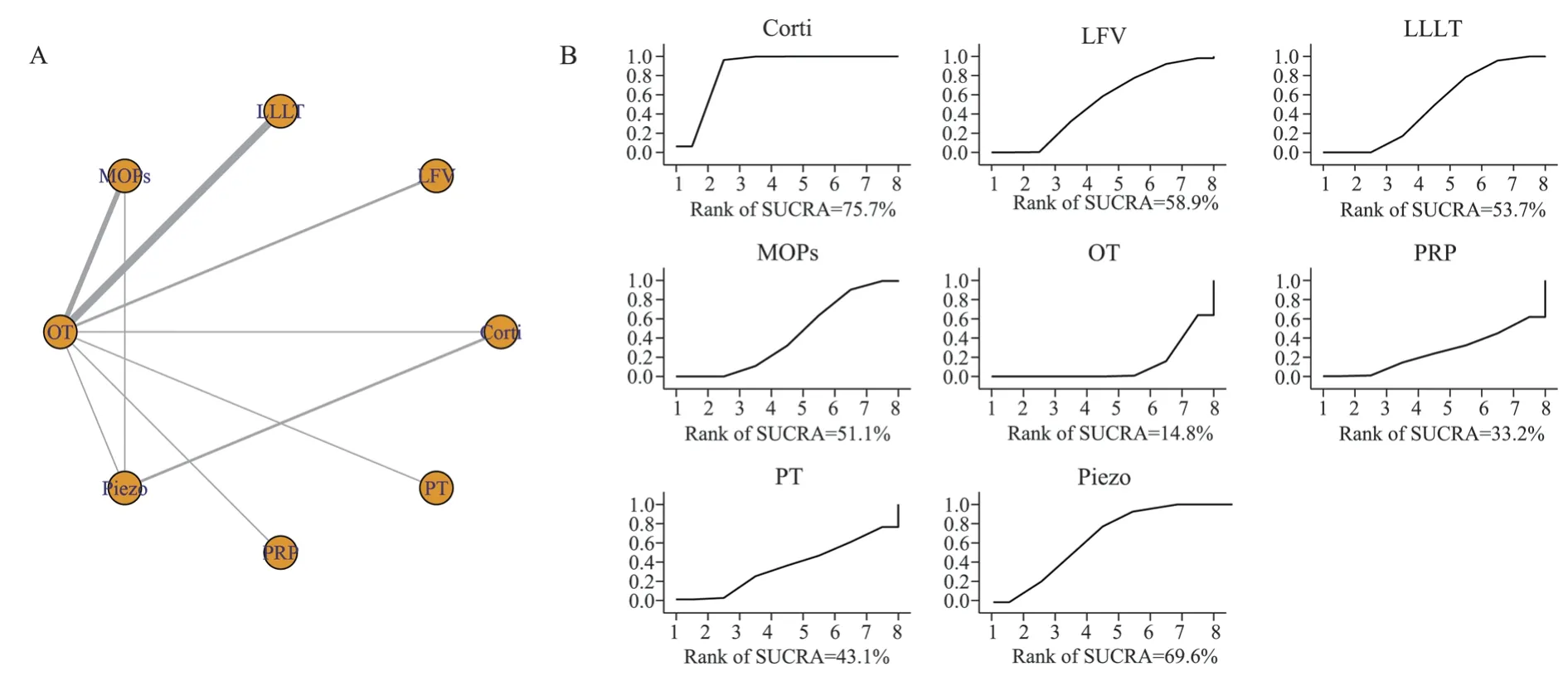
Fig 4 The canine movement distance at 2 months 4a Network evidence figure; 4b Figure of SUCRA

Fig 5 The canine movement distance at 3 months
4.Discussion
Orthodontic tooth movement acceleration has been a hot topic of research.As far as the available research is concerned,reducing orthodontic treatment time There are two broad categories of modalities; one is the use of bracket force application design and personalised orthodontic digital systems to predict the angle and speed of tooth movement to achieve efficient treatment and shorten orthodontic time.The other category is to accelerate the process by promoting periodontal reorganisation and alveolar bone remodelling through surgical or non-surgical interventions to improve orthodontic efficacy.Currently, there are many studies on acceleration tials of various adjunctive interventions, but there is no agreement between studies on the dominance of surgical and yon-surgical interventions in accelerating orthodontic tooth movement Abdelhameed49 concluded that surgical interventions are more effective than nonsurgical interventions in OTM and suggested that the combination of LLLT with piezoelectric annuloplasty produces acceleration stronger than that of LLLT and piezoelectric annuloplasty.In contrast,Türker et al.found that while non surgical interventions appeared to be more effective during the first 4 week period, non-surgical and non-surgical interventions had similar effects on orthodontic tooth movement when continued to 12 weeks.In addition,Abdarazik51 suggested that there is no significant difference between surgical and non-surgical interventions for the acceleration of 0TM.Different acceleration methods affect OTM through different mechanisms of action PRP is an autologous blood extract rich in growth factors,growth factors produce influence they directly increase the number of osteoclasts stimulating bone resorption and promote the process of bone reconstruction.Photobiomodulation,LLLT belongs to the physical methods that affect the cells at the molecular and chemical levelstimulating the production of adenosine and decreasing the level of reactive oxygen species,this structural effect stimulates the receptor activator of nuclear factor kB ligand (RANKL) molecules to play a balancing and regulatoryrole in the process of osteoblasts’differentiation, activation, and survival, osteoblasts’ differentiation and function are controlled by the RANKL/RANK/ OPG regulatory axis.Increasing the RANKL/OPG ratio favours osteoclast formation and activation,resulting in bone resorption occurring guided to an accelerated rate of OTM.DAD,Corti,Piezo, MOPs and other surgical procedures, on the other hand, derive from the principle of locally accelerated RAP phenomenon, which begins a few days after osteotomy and reaches its peak at 1 to 2 months.As the cusps move backwards,the cusps move faster and tooth movement induces more RAP,i.e., the orthodontic force accelerates the RAP phenomenon.However,Alfawal9reported that by the 2nd month,the speed of movement begins to decrease, which may be caused by a gradual decrease in RAP over time Aksakalli8 reported in his study that there was less loss of fulcrum resistance on the corticotomy side of the bone compared to the control group, which may be due to the fact that the alveolar bone reaction due to the localised incisional manipulation did not have an effect on the posterior segmental alveolar bone.This is also a side note that corticotomy is not a whole bone movement, it is a local acceleration theory.Whereas,Alikhani10 found that on the 14th and 28th day after undergoing bone corticotomy days, reporting minimal postoperative discomfort and pain in patients.These mechanistic differences in the different measures affect osteoclastsmay be one of the specific reasons for the differences in the results of different studies.
Based on traditional meta-analysis,the existing studies mainly compared the intervention group with the control group from a certain measure.Guo Ziyuan et al concluded that compared with the traditional orthodontic treatment, low-energy laser treatment promoted orthodontic tooth movement at 1 week,12 and 3 month energy density of 0-10 J/m2was better than that of 10-25 J/m2.Aboaf53 concluded that osteocorticotomy, piezoelectric annuloplasty, and MOPs were effective in accelerating tooth movement with decreasing acceleration intensities, and there was no significant difference between the three measures in terms of loss of support, periodontalindex and incidence of root resorption.In this study, we used Bayesian mesh Meta method SUCRA ordinal chart to compare the differences in enhance between groups, and used time as the classification criterion for the outeome index to directly or indirectly compare the effects of different interventions on accelerating orthodontic tooth movement, which were ranked one by one by the results of the SUCRA ordinal chart.Based on the results of this reticulated meta-analysis,PMT(90.6%)Piezo(87.4%)and MOPs(73.6%)were the top three ranked interventions to improve the efficiency of cusp movement at the time point of January,and Corti(75.7%),Piezo(69.6%)LFV(58.9%) were the top three ranked interventions to improve the efficiency of cusp movement at the time point of February.the top three interventions for improving the efficiency of cusp movement.At the point of 3rd month,Corti(73.3%)LLLT(68.4%)and LFV(60.8%) were the top three interventions for improving cusp movement efficiency.The top three interventions in terms of efficiency.At the same time,PRP was the least efficient group of interventions for cusp movement at all three time points:1 month,2 months and 3 months.It was found that both PBMT and Piezo had a significant effect on cusp movement efficiency at 1 month, while Corti and LFV had a better effect on cusp movement efficiency at 2 and 3 months.
Limitations:(1) Fewer follow-up reports were included in the study,and the adverse effects such as orthodontic root resorption, whether there is any loss of orthodontic support, and long-term stability need to be further investigated.(2) Most of the results reported in the current literature are of short duration, with an average followup time of only 3 months.(3) Some of the included studies did not report random methods, blinding, allocation concealment, etc.Gender, age, and race may be confounding factors when analysing the rate of tooth movement, and there may be a variety of biases such as selection and measurement.(4) Given the specificity of the interventions, it is difficult to align the frequency of interventions and treatment courses of surgical and non-surgical treatments, and there is potential inconsistency.
In this study, PBMT and Piezo showed a significant improvement in cusp movement efficiency at 1 month of use, while Corti and LFV showed better results in cusp movement efficiency at 2 and 3 months of use.Due to the limitation of the number and quality of the included studies, the above conclusions need to be verified by more high-quality studies.Clinical practitioners need to treat the results with caution and refer to the results of the present study under the principle of diagnosis and treatment, and relate the results to clinical practice.In order to improve the quality of orthodontic treatment, it is important to select an adjunctive intervention that combines safety,efficacy and patient acceptance Clinical efficacy.
Authors’ contribution statement: The first author Chen Huiying was responsible for writing the article, Zhan Le and Wan Ni were responsible for literature screening, Mo Liwen assisted in extracting information from the literature, and corresponding author Zhang Li was responsible for selecting, designing and reviewing the article.
All authors of this article declare no conflict of interest.
杂志排行
Journal of Hainan Medical College的其它文章
- Effect of honokiol regulating SIRT3 on chronic hypoxia-induced microglia and astrocyte polarization
- SLC6A8 promotes liver cancer cell proliferation by regulating mitochondrial autophagy through BNIP3L
- Clinical characteristics of patients with early-and late-onset optic neuromyelitis optica spectrum disease
- Distribution of gene polymorphisms associated with aspirin antiplatelet in the Han NSTEMI population
- Predictive value of systemic immunity index for sepsis in low-medium risk community-acquired pneumonia
- To analyze the differentially expressed genes in chronic rejection after renal transplantation by bioinformatics
